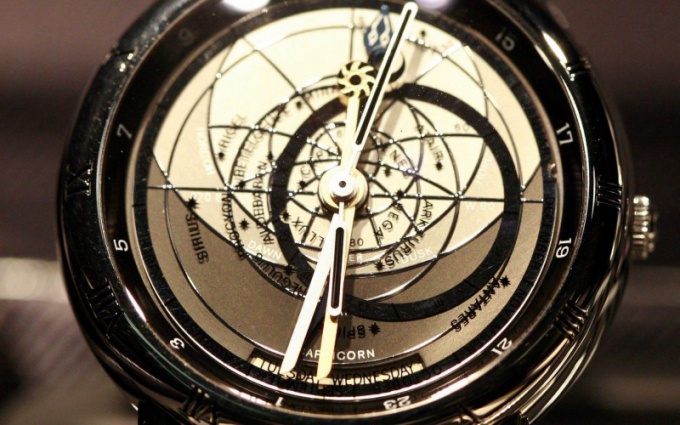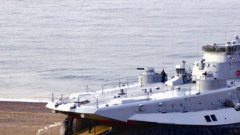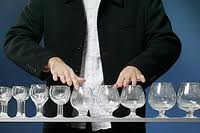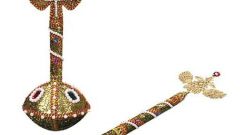The astrolabe is one of the first instruments, which was determined by the height of the Sun or stars, and according to them the coordinates of a point on the earth's surface.
In ancient times an astrolabe called the "spider". It really is reminiscent of a spider. The basis of it – a circle with a high rim, within which is embedded a disc is plotted in stereographic projection lines of the celestial sphere and points. In the center of the disc are built in concentric circles the celestial pole, celestial equator, North and South tropics. Marked on the disk of a celestial Meridian and latitude and azimuth circles. For leveling the applied suspension ring. "Spider" is a circular grating coated the brightest stars, the zodiacal circle. The zodiacal circle has a scale. All the parts are connected together by the axis.
The altitude of the Sun was determined with a ruler, which is called "alidada". Then the observer turned the "spider" to the desired point on the Ecliptic and to the small circle, which is called "almukantarat coincided. Thanks to this activity on the outside of the device turned out a stereographic projection of the sky at the moment.
The astrolabe first appeared in Ancient Greece. Accordingly, from the ancient Greek language it's her name, literally meaning "one who takes the stars." One of the first detailed descriptions of this tool leads Vitruvius in book about architecture. It also specifies the name of the inventor – Eudoxus, Apollonius he Pelski. The tool, which was invented by Eudoxus, was a drum with the picture of the starry sky.
In that era there were several types of such tools, they still were not quite similar to astrolabe in later eras. In its more or less its present form, this tool was made by Theon. This happened in our era, in the fourth century. To the same epoch belong the treatises on this tool. The astrolabe served as a tool to determine the time.
From Greece it has happened in the East. Arab scholars used it not only for astronomical, but for mathematical purposes. In Western Europe in Crusader times used the Arabic astrolabe. Then the Europeans themselves have begun to make such tools. Appeared scientific works. One of the treatises written by the great English writer, Geoffrey Chaucer.
During the Renaissance astronomy was extremely popular science. Any educated person should know this science. In turn, the most important section of astronomy was the study of the astrolabe. Tools of that time differed not only accuracy, but also exquisite appearance. Collecting the instruments was a good tone, fashion. To have survived the Royal collection, which now adorn the greatest museums in the world. One of the most famous artists of the time – the Dutchman Gualterus, Aresius.
How to construct an astrolabe
In ancient times an astrolabe called the "spider". It really is reminiscent of a spider. The basis of it – a circle with a high rim, within which is embedded a disc is plotted in stereographic projection lines of the celestial sphere and points. In the center of the disc are built in concentric circles the celestial pole, celestial equator, North and South tropics. Marked on the disk of a celestial Meridian and latitude and azimuth circles. For leveling the applied suspension ring. "Spider" is a circular grating coated the brightest stars, the zodiacal circle. The zodiacal circle has a scale. All the parts are connected together by the axis.
The altitude of the Sun was determined with a ruler, which is called "alidada". Then the observer turned the "spider" to the desired point on the Ecliptic and to the small circle, which is called "almukantarat coincided. Thanks to this activity on the outside of the device turned out a stereographic projection of the sky at the moment.
A native of antiquity
The astrolabe first appeared in Ancient Greece. Accordingly, from the ancient Greek language it's her name, literally meaning "one who takes the stars." One of the first detailed descriptions of this tool leads Vitruvius in book about architecture. It also specifies the name of the inventor – Eudoxus, Apollonius he Pelski. The tool, which was invented by Eudoxus, was a drum with the picture of the starry sky.
In that era there were several types of such tools, they still were not quite similar to astrolabe in later eras. In its more or less its present form, this tool was made by Theon. This happened in our era, in the fourth century. To the same epoch belong the treatises on this tool. The astrolabe served as a tool to determine the time.
From Greece it has happened in the East. Arab scholars used it not only for astronomical, but for mathematical purposes. In Western Europe in Crusader times used the Arabic astrolabe. Then the Europeans themselves have begun to make such tools. Appeared scientific works. One of the treatises written by the great English writer, Geoffrey Chaucer.
The cornerstone
During the Renaissance astronomy was extremely popular science. Any educated person should know this science. In turn, the most important section of astronomy was the study of the astrolabe. Tools of that time differed not only accuracy, but also exquisite appearance. Collecting the instruments was a good tone, fashion. To have survived the Royal collection, which now adorn the greatest museums in the world. One of the most famous artists of the time – the Dutchman Gualterus, Aresius.









